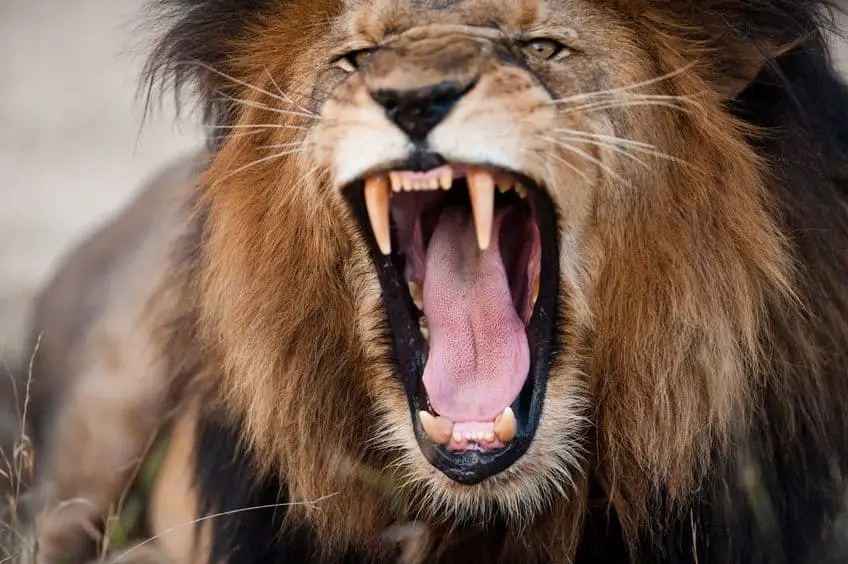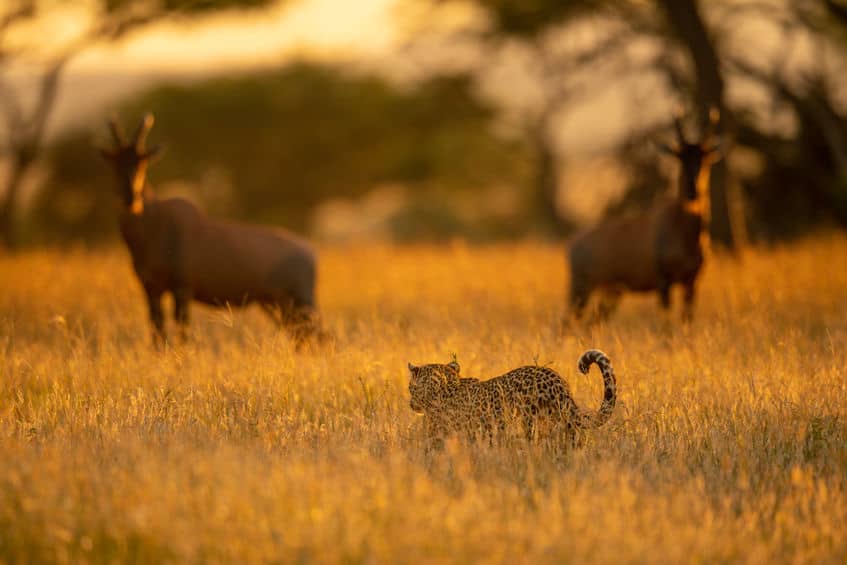
Two of the most majestic animals you can see in Africa are without a doubt, lions and leopards. But how do they compare? Are lions or leopards stronger? I have written this post to investigate that question
Lions are significantly larger than leopards and also have more bite force. Leopards, however, have the strength to carry prey even larger and heavier than themselves up into trees where it can keep it safe from other predators.
As you can probably imagine, the full answer is a bit more complex and depends on what exactly you are asking so I have compared the following four attributes and then written my conclusion to get a more detailed answer to the question of whether lions or leopards are stronger.
- Size
- Bite force
- How they handle competition
- Hunting style and strengths
Lions and Leopards Size Comparison
For us to be able to properly compare how strong lions and leopards are, it is important to first have an idea of how their sizes are compared to each other as size and weight gives several physical advantages when it comes to hunting and overpowering prey.
I have made this table that compares the size of lions and leopards:
| Lion | Leopard | |
| Weight | Males: 150-272 kg. (331-600 lb) Females: 120-180 kg. (264-397 lb) | Males: 20-91 kg. (44-200 lb) Females: 17-58 kg. (37-128 lb) |
| Height (shoulders) | Males: 1.2 meters (3 feet 11 inches) Females: 1.1 meters (3 feet 7 inches) | Males: 60-70 cm. (1 foot 11 inches – 2 feet 4 inches) Females: 57-64 cm. (1 foot 10 inches – 2 feet 1 inch) |
| Length (body) | Males: 1.7-2.5 meters (5 feet 7 inches – 8 feet 2 inches) Females: 1.4-1.8 meters (4 feet 7 inches – 5 feet 11 inches) | 90-160 cm. (2 feeet 11 inches – 5 feet 3 inches) |
As you can see in this table, lions are significantly larger than leopards which of course gives them some physical advantages. For instance, since lions are so much larger than leopards, they can take down prey that is significantly larger than leopards can.
The numbers I have used in this table include some records. For instance, 272 kg. and 91 kg. are the largest male (they usually get larger than females) lions and leopards ever recorded. The reason why I chose to include these numbers rather than just an average is to showcase just how large these incredible big cats of Africa can get.
The average weight of male lions and leopards is a fair bit lower at 190 kg. for male lions and 30 kg. for male leopards.
Female lions can actually grow to become the largest female cats on the planet, surpassing even female Siberian tigers. Male Siberian tigers, however, can become larger than both male and female lions.
The size of each individual lion and leopard depends largely on external factors such as their territory, what sources of food (prey) are available to them, and how many (and which) natural enemies they have in that territory.
Size is not everything though. Far from it. Leopards have some other cool strengths and advantages I will get into in just a bit.

Lions Have Stronger Bite Force
Since both lions and leopards are predators who use their strong jaws and sharp teeth to kill and devour prey, the next attribute we will take a look at is their bite force.
Aside from being the largest cat in Africa by a very large amount, lions are also the African cats with the strongest bite force. Lions’ bite force exceeds that of leopards even when you take their different size into account.
That being said, both cats have incredibly strong jaws and their bites are several times stronger than humans’.
Lions have a bite force quotient (BFQ), which is their bite force divided by their body mass, of 112, and leopard have a BFQ of 941.
Cats have large canine teeth that are designed for ripping flesh apart rather than for chewing. Flesh is also more easily digested than plants for the big cats and since their food consists almost exclusively of meat, there is no need for them to chew their food very well so they often just swallow whole pieces of flesh.
Sometimes lions can go for several days without eating so when they do, they really dig in. They can eat up to as much as 20% of their body weight in a single day which for the large males can be as around 45 kg. (99 lb) of meat in a single day.
Before they can get to eat though, they need to hunt and catch some prey. Lions and leopards also have quite different strengths and strategies when it comes to hunting.

Lions and Leopards Have Very Different Hunting Styles
Lions hunt in groups or prides, and leopards are solitary creatures. This important difference between them requires them to use different methods and utilize different strengths when it comes to hunting.
While lions most often hunt with their pride, they can also hunt alone. On their own, they can take down warthogs, zebras, and most antelopes.
One of the really big strengths lions have when they hunt, however, is the power of numbers that comes from hunting as a group. As a group, lions can take down prey much larger than themselves and have been seen hunting, and successfully taking down very large African mammals such as fully grown buffalos and giraffes and even white rhinoceroses and young elephants. The latter, however, is less common than the former since the thickness of elephants’ and rhinos’ skin makes it harder for lions to kill and eat them.
Another huge advantage lions get from hunting with their pride is that they seem to have some very impressive coordination skills. Lions have been seen trying to lure prey animals into a trap by forcing them to move closer to the rest of the pride.
Leopards are solitary creatures and do not benefit from the advantage of hunting as a group which lions do so they need to have exceptional strength on their own.
Leopards are also significantly smaller than the lion so they are not able to hunt the same large prey that lions are. Lucky for the leopards, they do not need to. Leopards can benefit from a much broader menu than lions and what they eat depends largely on their territory and what prey animals are available to them.
Leopards’ target prey ranges from small critters, frogs, and even fish and birds to medium-sized antelopes. Their favorite source of food seems to consist of impalas, springboks, and other similarly sized hoofed mammals.
Leopards rely on stealth and camouflage and when it comes to being elusive and sneaking up on prey without being noticed, no big African cats come even remotely close to leopards. Leopards utilize an arsenal of super-sensitive senses to move around completely silently and will usually get within just a few meters of their target prey before they strike.
After leopards catch their prey, they make good use of another one of their major strengths which is climbing. Lions are not even close to being as skilled at climbing as leopards are. Leopards have incredibly strong necks and are built in a way that allows them to carry prey even larger and heavier than themself high up into trees where they can keep it safe and stay in peace from other predators such as lions, hyenas, or African wild dogs.
Since lions and leopards have such different strengths and hunting styles, they also handle their competition quite differently. We will look at this now.

Handling the Competition
Lions are known to sometimes kill other African predators and even their babies but they do not seem to eat them. It seems rather as if they are attempting to eliminate their competition. This suggests an impressive intelligence in lions since they know that these other predators could potentially become an issue for them in the future.
Leopards are among lions’ competition and if you are lucky, you can sometimes see a lion or even a couple of them chasing a leopard to try to steal its prey. Since leopards are such amazing climbers, they will often utilize this skill when escaping from lions (or other predators such as spotted hyenas) and escape up into a tree. If they have the time before the lions get to them, they will also make sure to secure their prey by hanging it over a large branch in a tree.
Since leopards’ food sources most often consist of prey that is significantly smaller than lions’ prey and by having a diet that is much more varied than many other predators, they can avoid most of the competition from other predators when it comes to hunting and eating.
It is, however, not uncommon for leopards to drop some of the food they have carried up into a tree. When this happens, scavengers such as spotted hyenas or African wild dogs will not be shy and will often try to steal the dropped food before the leopard has a chance to reclaim it.

In Conclusion
Now that we have covered what I see as four of the most notable differences when it comes to how strong lions and leopards are, it is time to draw some conclusions.
Lions are physically stronger than leopards. Part of the reason why lions are stronger than leopards is that lions are significantly larger than leopards. This gives them some physical advantages such as being able to take down prey much larger than what leopards are capable of. Another big advantage lions have when it comes to hunting is through the power of numbers since they usually hunt as a group and therefore can outnumber and surround target prey animals. Lions also have a stronger bite than leopards.
Leopards on the other hand have developed some different skills and strengths at which they easily outcompete lions.
Leopards rely on stealth and camouflage to a much larger degree than lions do. Leopards can move around and sneak up on their completely unsuspecting target without being noticed until it is much too late for the target prey animal to escape. After the kill, leopards even have the strength to carry their freshly caught prey, which can be much larger and heavier than the leopard itself, high up into the treetops by using its excellent climbing skills to navigate and move up the tree while carrying the prey in its strong jaw. This is something lions are not at all capable of.
So whether lions or leopards are stronger depends on what exactly you are asking and what attributes you are looking at but one thing is for sure; both lions and leopards are incredibly strong animals and have different strengths and advantages which they each excel at.
